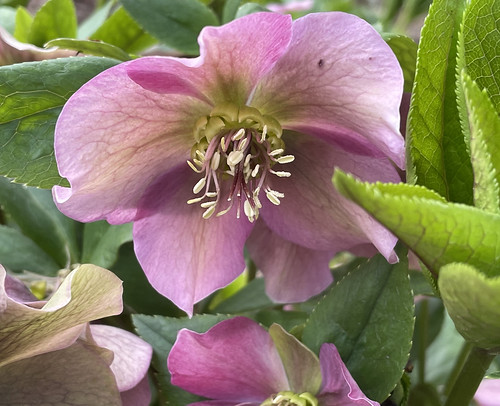I can never remember the name of this flower.
It's Helleborus. It looks a lot like another flower I have trouble remembering, Ranunculus. Ridiculous! I end up referring to it as "Homunculus," which I know is wrong, but amuses me to say. In truth, a "homunculus" is...
... a representation of a small human being. Popularized in sixteenth-century alchemy and nineteenth-century fiction, it has historically referred to the creation of a miniature, fully formed human....
The homunculus first appears by name in alchemical writings attributed to Paracelsus (1493–1541). De natura rerum (1537) outlines his method for creating homunculi: That the sperm of a man be putrefied by itself in a sealed cucurbit for forty days with the highest degree of putrefaction in a horse's womb, or at least so long that it comes to life and moves itself, and stirs, which is easily observed. After this time, it will look somewhat like a man, but transparent, without a body. If, after this, it be fed wisely with the Arcanum of human blood, and be nourished for up to forty weeks, and be kept in the even heat of the horse's womb, a living human child grows therefrom, with all its members like another child, which is born of a woman, but much smaller.
That's rather crazy, no? Here's a picture of Paracelsus:
Excellent! From the Wikipedia article about him:
Paracelsus was born in Egg, a village close to the Etzel Pass in Einsiedeln, Schwyz....That doesn't sound real — Egg... Etzel... Schwyz!
He was prone to many outbursts of abusive language, abhorred untested theory, and ridiculed anybody who placed more importance on titles than practice...
His hermetical beliefs were that sickness and health in the body relied upon the harmony of humans (microcosm) and nature (macrocosm).....
An example of this correspondence is the doctrine of signatures used to identify curative powers of plants. If a plant looked like a part of the body, then this signified its ability to cure this given anatomy. Therefore, the root of the orchid looks like a testicle and can therefore heal any testicle-associated illness....
Paracelsus viewed the universe as one coherent organism that is pervaded by a uniting lifegiving spirit, and this in its entirety, humans included, was 'God.'...
Paracelsus also described four elemental beings, each corresponding to one of the four elements: Salamanders, which correspond to fire; Gnomes, corresponding to earth; Undines, corresponding to water; and Sylphs, corresponding to air.
Salamanders, Gnomes, Undines, and Sylphs — How exciting science was in the 16th century!
FROM THE EMAIL: Caroline writes:
Down here in Texas Helleborus is known as Lenten Rose.
Yes, we say that too. Somehow, I also find that hard to remember too. I think it's like Easter lily, but it's not Easter lily....
Enjoyed your discussion of Paracelsus. I tend to think those guardians of an ancient wisdom knew so much more than we deracinated moderns. For instance, a worldview that takes Creation as a given, and homo sapiens’ call to live in harmony with it. My theory is that the obsession with climate « change » is a misguided response to a near universal inkling that the way we are living is neither sustainable nor tending toward human flourishing. Modern man is profoundly out of synch with created order, having seized control of his fertility, sexuality, gender, and genetic material. We long to live in harmony with the environment because the longing is written on our hearts. At the same time, we want to be as gods, dispensing life and death as befits our disordered desires. So we focus relentlessly on CO2 and gmos even though we are gmos, secreting our synthetic, performance enhancing, baby suppressing hormones into rivers and streams. Kind of like focusing on The Confederacy instead of the septicemia infecting our institutions. Cf Walker Percy.
AND: A reader named Chris who has been told he looks like Paracelsus asserts that you can't talk about Paracelsus without bringing up this quote of his: "The dose makes the poison."






